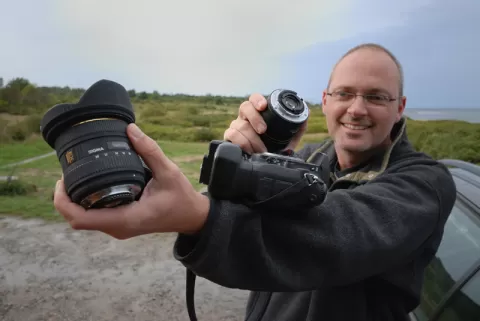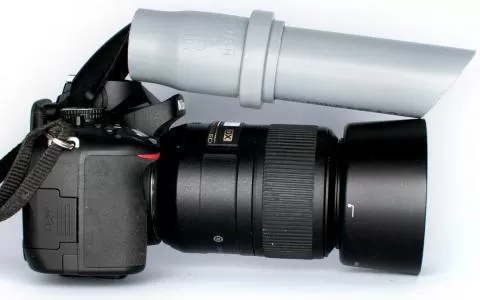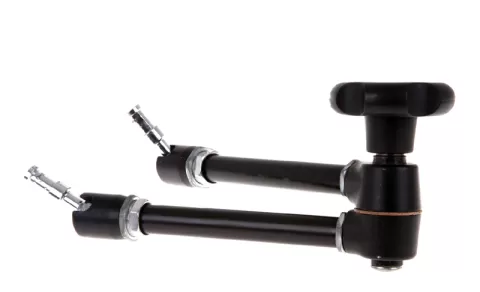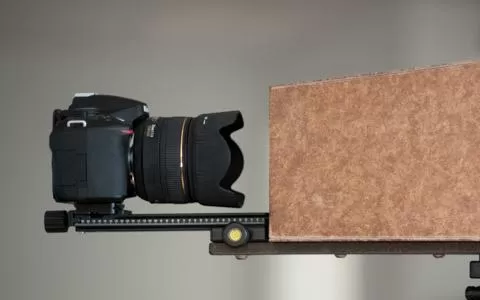I have been using the Manfrotto Arms extensively in stead of tripods and other camera platforms. Here are my experiences.
I have a handful of tripods and monopods, and use them regularly. But in most cases they are actually a little cumbersome to use, and I prefer using the Manfrotto arms, which take up less space and are more flexible.
Holding and Friction
I have two types of arms from Italian Manfrotto: one Holding Arm and three Friction Arms. I also have a handful of Super Clamps and various other gadgets and gizmos that can be combined with the arms and clamps.
Let me first cover the basic arms, and then go through the accessories and how I use it all.
The arms are fairly simple constructions when seen from the outside: two sections connected with a ball joint. Each of the sections also has a ball joint at the end, and when these joints are loose, the arm can be adjusted to a wealth of configurations.
When you loosen the central joint, all three joints will become limp and adjustable, and likewise, when you tighten the middle one, the whole arm goes rigid.
The two types – Holding and Friction – differ in the tightening mechanism. The Holding Arm has a lever that you turn "on" and "off" and loosen or tighten with a snap. Once loose, the arm is very limp, and once tightened, it's all firm. The Friction Arm has a knob, which gradually loosens and tightens the arm, hence the name friction. You can set it all tight, but also have it just loose enough to be able to move and flex, but still hold its position.
My preference
I prefer the Friction Arm, which I find easier to operate and smoother to use. The single lever Holding arm requires a lot of force to lock and unlock, and mechanically it doesn't feel as nice as using the knob. I have broken two Holding Arms (and had them replaced on the warranty), while I have never had any issues with the Friction Arms. I see both used equally often out in real life, but I certainly prefer the Friction model myself.
It enables me to more finely adjust the position before locking the arm, and locking doesn't move the arm, which in my experience often happens with the Holding Arm. Since my use often requires precise positioning for macro work, the more delicate mechanism of the Friction Arm is my choice.
And when I say delicate, don't misunderstand me. These arms are built like tanks, and can basically hold almost anything you can mount on them, although Manfrotto does specify a 3 kilo load limit.
Clamps
The arms end in two inside threaded studs. one has a 1/4" thread and the other has a 3/8" thread. This enables you to mount any 1/4" or 3/8" outside threaded thing in either end. Small thread converters are easily available and work like a charm, and if you have a female thread on your accessory, you can use a small threaded rod for the connection.
For the arms to be useful, you need clamps. I have had no reason to look at anything else than Manfrotto's own Super Clamp. It's an inexpensive and very versatile clamp, built to last a lifetime and perfectly suited to work with the arms. You enter one stud into the clamp, lock it and tighten the clamp to something steady. The clamp is a crude and powerful piece of mechanics, and you need to take care not to crush anything then you tighten it. It easily converts from grabbing thick and thin boards as well as pipes and tubes. It's the perfect companion to the arms. You need one for each arm, and maybe an extra or two for convenience.
Mounting something
Once the clamp end is taken care of, you need to mount something on the business end of the arm: a camera, a light, a reflector or whatever. I have a handful of different mounting options, but most often use these:
- A ballhead with an Acra-Swiss quick release, which fits all my cameras and lenses.
- A Manfrotto flash bracket that can hold flashes, reflectors and umbrellas.
- An LED light panel - it's basically permanently mounted on one of the arms, and can be battery or AC-powered.
Mounting a camera
I have bought a cheap ballhead and permanently mounted it on one arm by using a small piece of 3/8" thread rod. This goes into one end into the arm and the ballhead goes onto that. It's not the sturdiest of mounts, but works well for my use. It ends in an Acra-Swiss quick release, and permits me to mount cameras, lenses, rails and much more. The ballhead allows for fine tuning the camera aim without having to loosen the arm.
One of the arms I bought came with a simple camera bracket, which can be used in a tight spot. It screws into the camera with a 1/4" thread and fits onto a stud on the arm. Since I have long ago standardized on Acra-Swiss, I rarely use this bracket.
Lamps and flashes
Flash brackets are essential when working with lamps and flashes. They add an extra joint as well as options to mount a flash or a lamp and an umbrella, a light box, a reflector or some similar contraption.
For my SB-800 flashes I have mounted studs on a couple of plastic feet, which have a slot for clicking in the flash. These sit in the flash brackets and allow me to mount a "bare" flash as well as one with a brolly or reflector.
I acquired a powerful LED-panel some years back, and that has a built-in bracket, which fits the Manfrotto studs perfectly and almost always sits on one of the arms for macro work.
Little extras
In order for all this to fit together I have a handful of little extras.
I already mentioned the 1/4" to 3/8" inch thread converters. I essentially have one mounted on any gadget I have with a 1/4" outside thread. They are cheap and can save the day when threads don't match. I also have a handful of 5/8" or 16mm studs (AKA spigots), which are much like the ones found on the arms, just loose. These can be used to connect anything built for studs, and offer outside threads in both sizes.
I also mentioned the threaded pieces, which are simply threaded rods cut into short 2cm or 1" bits. One of these can connect two female threaded pieces.
Other arms and extenders
One extender is offered by Manfrotto. This is a simple metal rod with a stud in one end and a hole for one in the other. You mount it in the clamp, and then mount the arm to it and it gives about 20 centimeters extra reach.
I purchased a couple of smaller no-name arms and a cell phone bracket, which I use for mounting my cell phone, mainly when I need to do video. They fit into the Super Clamps and accept 1/4" threaded accessories, so they can be used for smaller cameras, flashes as well as the phone.
I also acquired a couple of so called booms, which are potentially very long and telescopic arms, that are mainly used for umbrellas and flashes. They fit into dedicated lamp stands, but can also be mounted on the Magic Arms, which is sometimes much more convenient and stable.
Convinced that it was simply brilliant, I bought a goose neck "rod", which is a flexible arm that fits in the clamps and takes the same accessories as the Magic Arms. But unfortunately what might seem as a fantastic idea, isn't that useful. The goose neck is too rigid and too soft at the same time, meaning that there's a limit to how much it can bend, and once it's in position it will slowly sag, even under a very light load. I basically never use it.
In practical use
I do quite a bit of macro work, and when shooting in tight spots, like on a table top, the arms are perfect, and a very good replacement for a tripod. The arm can reach quite far, and I often use one mounted on the table's edge, carrying a camera pointed towards myself and the stuff that I'm working with. Since my worktable is up against a wall, a tripod wouldn't be able to do this unless it had a very long extension – or a lot of space on the table.
As mentioned elsewhere, I'm also a wheelchair user, and when in the wheelchair, it's much easier to clamp the camera to the chair than it is to carry and set up a tripod. I simply clamp the arm to a tube on the chair, and it actually reaches far enough to bring the camera to eye level.
I wouldn't do that!
Stability
I remember seeing renowned Nikon photographer Joe McNally doing a series of shots of a fire engine, and clamping his large SLR on the outside of the truck using these arms and shooting remotely while it was driving. I wouldn't do that!
These arms are stable, but my experience is that they can be shaken loose, and once that happens they soon go all limp. They won't drop what they are carrying, but sure can cause some damage to your gear – and of course compromise your whole setup.
If I have a camera clamped to my wheelchair and roll over some cobblestones or uneven ground, the vibrations will often cause the arm to go loose, no matter how much I have tightened it. For static work they are totally reliable and stable, and definitely my preferred way to hold stuff.















